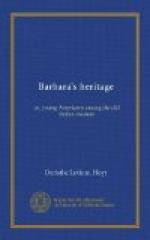“This is a good time in which to explain my meaning. Titian’s nature was not devout. You will see it in every one of these religious paintings you are about to study. The subjects seem only pretexts, or foundations, for the gorgeous display of a rare artistic ability. To paint beauty for beauty’s sake only, in form, features, costumes, and accessories was Titian’s native sphere, and gloriously did he fill it. In these church pictures, the Madonna and Child are almost always entirely secondary in interest. In many, the family of the donor, with their aristocratic faces and magnificent costumes, and the saints with waving banners, are far more important. A fine example of this is the Madonna of the Pesaro family in the Church of the Frari. With such a motif underlying his work, the great painter fell easily into the habit of portraying ideal figures, especially of women,—’fancy female figures,’ one writer has termed them,—whose sole merit lies in the superb rendering of rosy flesh, heavy tresses of auburn hair, lovely eyes, and rich garments. Such are his Flora, Venuses, Titian’s Daughter—of which there are several examples—Magdalens, etc.; together with many so called portraits, such as his La Donna Bella in the Pitti, Florence.
“Titian could paint such pictures so free from coarseness, so magnificent in all art qualities, that the world was delighted with them. After him, however, the lowered aim had its influence; poorer artists tried to follow in his footsteps, and the world of art soon became flooded with mediocre examples of these meaningless pictures. All this hastened rapidly the decay of Italian art.
“But you must remember,” Mr. Sumner hastened to say, as he watched the faces about him, “that I am giving you my own personal thoughts. To me, the purity of sentiment and the lofty motif of a picture mean so much that they always influence my judgment of it. With many other people it is not so. They revel in the color, the line, the tone, the grouping, the purely art qualities. In these Titian, as I have said, is perfect, and worthy of the high place he holds in the art-world.
“I hope you will take great pains to study him here by yourselves,—in the Academy and in the various churches,—wherever there are examples of his work. Let each form his own judgment, founded on that which he finds in the pictures. The work of any artist of the High Renaissance, whose aim is purely artistic, is not difficult to understand. His means of expression were so ample that it is easy indeed to read that which he says, compared with the earlier masters. You will find two of Titian’s most notable pictures in the Academy,—the Assumption of the Virgin, one of the few in which the Madonna has due prominence, and which shows the artist’s best qualities, and Presentation of the Virgin.”
“What other Venetian Masters ought we particularly to study?” asked Barbara.




